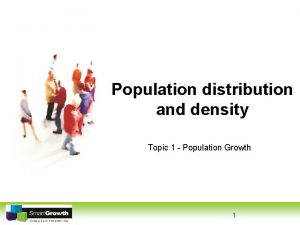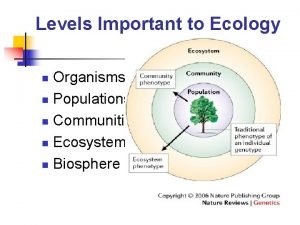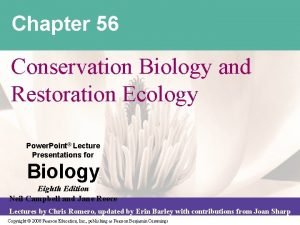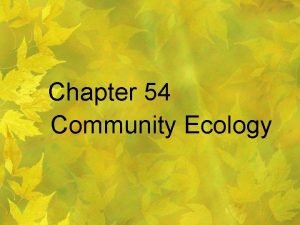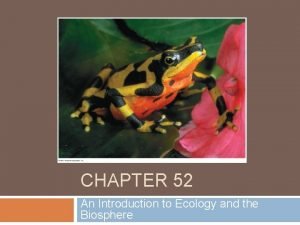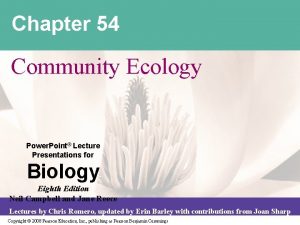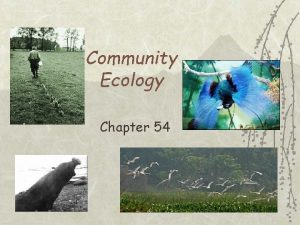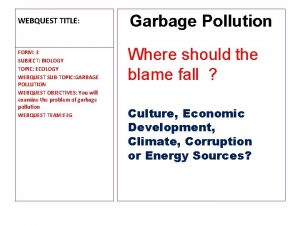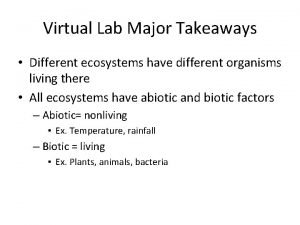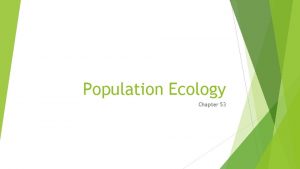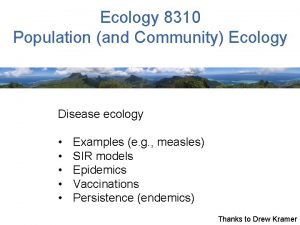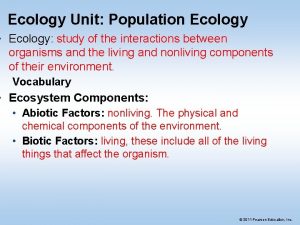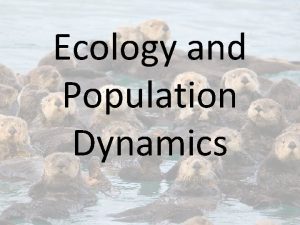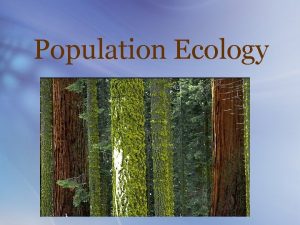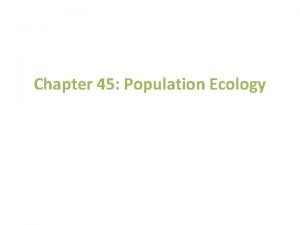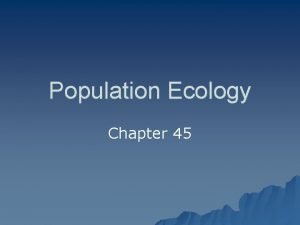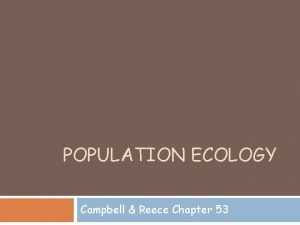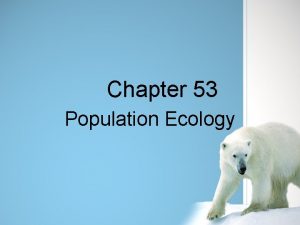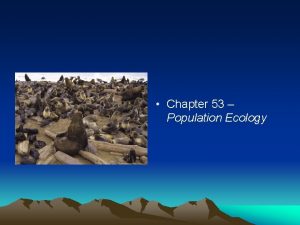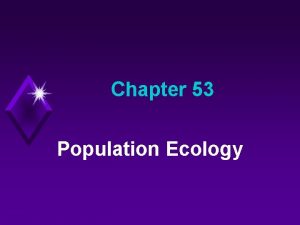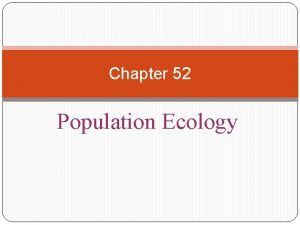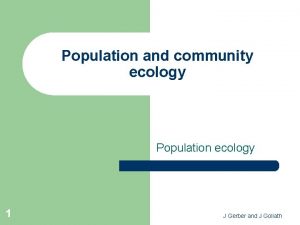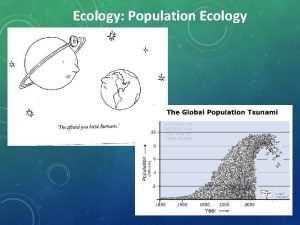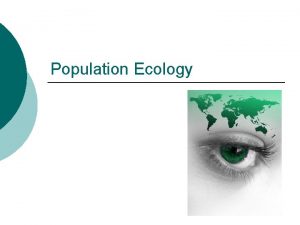Chapter 5 Population Ecology POPULATION 5 1 How







































- Slides: 39

Chapter 5: Population Ecology POPULATION

5. 1 How Populations Grow 4 Things Ecologists Study about Populations: A) Geographic Distribution/ Range – area inhabited by a population ex: humans range include all continents! B) Density and Distribution – number of individuals per unit area AND how they are spaced out across the range RANDOM UNIFORM CLUMPED

How Ecologists Study Populations Growth Rate – determines whether population will increase, decrease or stay the same (zero) Age Structure – number of males and females of each age within a population C) D) ¡ ¡ Reproduction doesn’t occur until a certain age Only females can reproduce… or can they?

Factors Affecting Population Growth 3 Factors that affect population growth: A) Birth and Death rates ¡ BR > DR Growth Migration -Immigration (entering) and emigration (leaving) B) ¡ Immigration > emigration Growth

Types of Population Growth Exponential Growth – unlimited growth of a population – J Shaped Curve A) ¡ ¡ ¡ Occurs when population has food, space, protection from predation/disease, removal of waste products (unlimited resources) Each future generation will grow faster than the last Ex: bacteria - cell reproduces every 20 minutes. How many after 20 min. ? How many after another 20 min? How many after one day?

Types of Population Growth Logistic Growth – population grows, slows, and eventually reaches carrying capacity S Shaped Curve B) ¡ ¡ n ¡ Phase 1 – exponential growth Phase 2 – slows down Due to: BR decreases, DR increases, immigration decrease, emigration increases Phase 3 – population stabilizes, reaches carrying capacity • Carrying Capacity – (k) maximum number of individuals than a particular environment can support

5. 2 – Limits to Growth Limiting Factors – factors that control the growth of a population B) Include: Competition, Predation, Parasitism/Disease, Extreme Climates, and Human Disturbances Classified as: ¡ Density Dependent Factors – factors that depend on the density of the population; control the populations and keep numbers in check n Non-native species have a tendency to elude this and grow uncontrollably due to lack of natural predators, etc. ¡ Density Independent Factors – factors that do NOT depend on the density of the population; will affect all populations equally, regardless of their size A)

Density Dependent Factors Competition A) ¡ ¡ ¡ Fighting for space, food, water, sunlight, mates, etc. Can be within the same or different species Some will survive and reproduce, some will survive but NOT reproduce, some will die : 0( Herbivory B) ¡ ¡ Predators to plant species Large loss of plant species may affect other primary consumers

Density Dependent Factors Predation C) ¡ Cyclic relationship (rise of one may induce the fall of the other; trend of rises and falls continues)

Density Dependent Factors Parasitism – feed at the expense of their hosts D) ¡ E) Ticks feeding on blood of dogs Disease – can cause a dramatic drop in a population due to infestation of a disease; decrease in one population may trigger a rise in another!

Density Dependent Factors Stress from Overcrowding – species fighting amongst themselves may lead to high levels of stress which may affect an organism’s ability to fight disease! F) ¡ Hmmmm…. might explain why students get sick right before tests…. maybe? ?

Density Independent Factors Weather A) ¡ Hurricanes, droughts, floods Natural Disasters B) Wildfires ¡ Volcanic eruptions HUMANS! ¡ 2004 Sri Lanka Tsunami

5. 3 - Human Population Growth Historical Overview • For a long time, human growth rate was low due to a high death rate • Harsh conditions • Lack of food • Predation • Disease Industrial Revolution • Human population begins to grow more rapidly due to reduced death rates • Improved nutrition • Improved sanitation • High birth rates remain

Malthus Prediction Human population cannot continue to grow exponentially forever Human population growth can be limited by n n q q q Competition (war) Limiting Resources (famine) Parasitism (disease )

The Effect of Age on Population n United States q Equal numbers of people in each age group q Slow but steady growth in the future Guatemala q Much higher numbers of young people q Prediction is that population size will double within 30 years Current Predictions for Our World: 9 billion people by 2050!

Chapter 6: Human Environmental Impact n Humans: q q “Humans affect regional and global environments through agriculture, development, and industry in ways that have an impact on the quality of Earth’s natural resources, including soil, water, and the atmosphere. ” Rely on Earth’s life-support systems Affect our environment when we: n n n Obtain food Eliminate waste products Build places to live

The Effect of Human Activity n Agriculture - Supplies a dependable food source that can be stored for later use q q n Positives n Enabled human settlements that ultimately led to modern civilization Negatives n Impacts natural resources as >7 billion people!!! need q Food q Fresh water q Fertile soil q Fossil fuels (fertilizer & farm equipment) Development - Trend to move to suburbs & cities q q Positives n High standard of living Negatives n Produce lots of waste that affect air, water, & soil resources n Uses up farmland n Divides natural habitats into fragments

The Effect of Human Activity n Industrial Growth – Industry & scientific know-how q q Positives n Modern conveniences of life n Comfortable homes, clothes, electronic devices Negatives n Require energy and consume power n Need to burn fossil fuels (coal, oil, & natural gas) n Wastes discarded into air, water, & soil Sustainable Development n Ecosystem Goods & Services q q The goods and services produced by ecosystems that benefit the human economy n Goods – things that can be bought & sold n Services – processes or actions that produce goods Examples n n Breathable air Drinkable water – can be provided naturally, but if polluted we must spend $$ to provide it

Sustainable Development n Renewable and Nonrenewable Resources q Renewable – can be renewed or replaced by a healthy ecosystem n q A single southern white pine Nonrenewable – natural processes cannot replenish them in a reasonable amount of time n n Fossil fuels (formed from buried organic material over millions of years) A whole forest of white pines

Sustainable Development n Sustainable Resource Use q Sustainable development n n q Provides for human needs & wants Preserves the ecosystems that produce natural resources What does it look like? n n n Does not cause harm to the soil, water, and climate Consumes as little energy and material as possible Flexible to survive environmental stress/disasters Takes into account human economic systems as well as ecosystem goods and services SURVIVE AND IMPROVE

Soil Resources n n n Why is it needed? q When healthy, supports agriculture and forestry q Topsoil – absorbs/retains moisture but allows water to drain What are we doing to destroy it? q Allowing soil erosion – nutrients are washed away with rain n Desertification – over-plowing, overgrazing, allowing land to be barren between plantings n Deforestation – loss of forests q Forests help to hold soil in place, absorb CO 2, absorb freshwater How can we protect it? q Leaving stems and roots in place between plantings q Crop-rotation q Contour Plowing and Terracing – creating steps to prevent water and soil from flowing downward q Creating tree farms (makes trees a renewable resource)

Freshwater Resources n n Why is it needed? q Drinking water q Industry q Transportation q Energy q Waste Disposal What are we doing to destroy it? q Overuse (Ogallala aquifer – took 1 million years to collect…non-renewable!!) q Pollution n Point (factories, oil spills) n Non-point (Grease and oil washed by rain off streets, chemicals released into air) n Industrial/Agricultural Chemicals q n Biomagnification – pollutants (like DDT, PCBs, heavy metals) magnify as they move through the food chain from primary producers to primary consumers, etc. Residential Sewage ( )

Freshwater Resources n How can we protect it? q Protection of natural resources involved in water cycle n Plants can filter out pollutants q Watershed conservation – protecting all inter-connected bodies of water q Pollution control n Sewage treatment n Decrease pesticide use q Use biological controls instead of poisonous sprays n Water conservation q Drip irrigation

Atmospheric Resources n Why is it needed? q Oxygen Absorption of UV radiation Regulation of global temperature q Pollution (Industry, Burning Fossil Fuels) q q n What are we doing to destroy it? n n n Smog - Ground Level Ozone q Causes respiratory diseases Acid Rain – nitrogen and sulfur oxides mixing with precipitation q Damages plants, releases toxic elements from soil Greenhouse Gases – burning of fossil fuels releases CO 2, CH 4 and H 2 O q Releases carbon dioxide into the air, contributes to global warming and climate change Particulates – microscopic particles of ash and dust released by industry q Can be inhaled and cause respiratory problems How can we protect it? q q q Emission standards Clean-air regulations Unleaded gasoline

Atmospheric Resources (continued) n What are we doing to destroy it? (continued) q Pollution (Industry, Burning Fossil Fuels) n n n Greenhouse Gases – burning of fossil fuels releases CO 2, CH 4 and H 2 O q Releases carbon dioxide into the air, contributes to global warming and climate change Particulates – microscopic particles of ash and dust released by industry q Can be inhaled and cause respiratory problems How can we protect it? q q q Emission standards Clean-air regulations Unleaded gasoline

Biodiversity: total of all the genetically-based variation in all organisms in the biosphere n Value of Biodiversity q q q n Ecosystem Diversity - variety of habitats, communities, and ecological processes in that biosphere n 1. 8 million species already identified! n 30 million more estimated yet to be discovered!! Species Diversity - number of different organisms in a particular area Genetic Diversity – sum total of all different forms of genetic information carried by a particular species Benefits of Biodiversity n n n Sources of medicines Genetic diversity used to increase pest resistance Keystone species (if removed) can change entire ecosystem

Biodiversity n Threats to Biodiversity q q q n Altering habitats Hunting Introducing Invasive Species Releasing Pollution Contributing to Climate Change Conserving Biodiversity q q q Protect Individual Species Preserve Habitats and Ecosystems Consider Local Interests

Invasive Species Pythons in Florida • Have few or no predators in new ecosystem • Use more resources or use resources more efficiently • May reduce the endemic (native) population via predation Invasive Species Disaster

Why is biodiversity important? n n The greater the VARIATION in an ecosystem, the more likely it is to RECOVER if there is a disruption. q Increased diversity = healthier environment. Biodiversity is a resource q Most pharmaceutical drugs from plants. q Future food sources, building materials, etc… q “Beauty, fascination, & wonder” q Recreation (ecotourism).

Threatened, Endangered, and Extinct Species n n n Threatened q Abundant in range, but decreasing in numbers. q At risk Endangered q Very few remaining in natural range q At risk for going extinct Extinct q Local extinction – gone from local range q Ecological extinction – gone from natural range (in zoos only) q Biological extinction – gone from Earth forever.

Meeting Ecological Challenges n Ecological Footprint – total area of functioning land water ecosystems needed both to provide the resources an individual or population uses and to make harmless the wastes that an individual or population generates n The average American has an ecological footprint that is: q 4 x larger than global average q 2 x that of England q >2 x that of England q 6 x that of China

Ozone Layer n n n Why is it needed? q Ozone Layer – molecules of O 3 q At ground level = danger; q Upper atmosphere = protection against harmful UV radiation which can cause cancer, eye damage and decreased immunity What are we doing to destroy it? q Primary problem is CFCs (Chloroflurocarbons) n Found in refrigerants, aerosol cans and plastic foams How can we protect it? q CFCs banned in the late 80’s (Montreal Protocol), however residual CFCs can remain in the atmosphere for more than 30 years!!

Fisheries n n What is the problem? q Despite increased efforts and new technology, seafood catch numbers continue to decline What are we doing to destroy it? q Fish thought to be a renewable resource q n Death rates (commercial fishing) surpassed the birth rates of the fish How can we protect it? q Regulations put in place to limit fish catches q Certain areas closed to fishing until populations recovered (Sustainable Fisheries Act) q Aquaculture – farming of aquatic animals

Climate Change n n What’s the Problem? q Global warming – increase in average temperature of our planet (0. 74ºC between 1906 and 2005) with 11 of the 12 warmest years occurring between 1995 -2006 q Melting sea ice q Rising seal levels What are we doing to destroy it? q “Enhanced Greenhouse Effect” not allowing solar heat to move back into outer space Burning fossil fuels n Automobile exhaust n Industrial pollution How can we protect it? q Alternative energy sources (water, wind, solar) q Decrease our ecological footprint n n

Greenhouse Gases n Methane, carbon dioxide, water vapor, ozone

HIPPCO – Factors Leading to Species Extinction 1. Habitat Loss q 2. 3. 4. 5. 6. “Hot spots” with greatest impact: tropical areas, coral reefs, wetlands, grasslands, water (fresh & salt) Invasive Species q Organisms not normally in habitat q Air, water, soil impacts q Arrival of humans and exponential population growth q Ocean Fisheries Pollution Population Climate Change Overexploitation

Terrestrial Biomes

Aquatic Biomes

 Chapter 4 section 1 population dynamics
Chapter 4 section 1 population dynamics Chapter 4 population ecology section 1 population dynamics
Chapter 4 population ecology section 1 population dynamics Section 1 population dynamics
Section 1 population dynamics Population ecology section 1 population dynamics
Population ecology section 1 population dynamics Chapter 53 population ecology
Chapter 53 population ecology Equilibrial life history
Equilibrial life history Ecology
Ecology Chapter 53 population ecology
Chapter 53 population ecology Chapter 4 population ecology answer key
Chapter 4 population ecology answer key Chapter 53 population ecology
Chapter 53 population ecology Population ecology example
Population ecology example The concept of population
The concept of population Fig 52
Fig 52 Ecosystem vs community
Ecosystem vs community Concept 3 population ecology
Concept 3 population ecology Lynx and hare relationship
Lynx and hare relationship Population characteristics ecology
Population characteristics ecology Population characteristics ecology
Population characteristics ecology What is population ecology
What is population ecology Population definition ecology
Population definition ecology Population distribution
Population distribution Parasitism
Parasitism Chapter 52 an introduction to ecology and the biosphere
Chapter 52 an introduction to ecology and the biosphere Study guide chapter 3 section 1 community ecology
Study guide chapter 3 section 1 community ecology Chapter 56 conservation biology and restoration ecology
Chapter 56 conservation biology and restoration ecology Chapter 55 ecosystems and restoration ecology
Chapter 55 ecosystems and restoration ecology Chapter 54 community ecology
Chapter 54 community ecology Chaparral climograph
Chaparral climograph Organism
Organism Principles of ecology chapter 2 section 1 answer key
Principles of ecology chapter 2 section 1 answer key Section 1 organisms and their relationships answer key
Section 1 organisms and their relationships answer key Chapter 2 principles of ecology answer key
Chapter 2 principles of ecology answer key Chapter 54 community ecology
Chapter 54 community ecology Chapter 55 ecosystems and restoration ecology
Chapter 55 ecosystems and restoration ecology Chapter 5 evolution and community ecology
Chapter 5 evolution and community ecology Chapter 5 evolution and community ecology answer key
Chapter 5 evolution and community ecology answer key Principles of ecology chapter 2 section 1 answer key
Principles of ecology chapter 2 section 1 answer key Chapter 54 community ecology
Chapter 54 community ecology Ecology webquest answers
Ecology webquest answers Food chain virtual lab
Food chain virtual lab




















